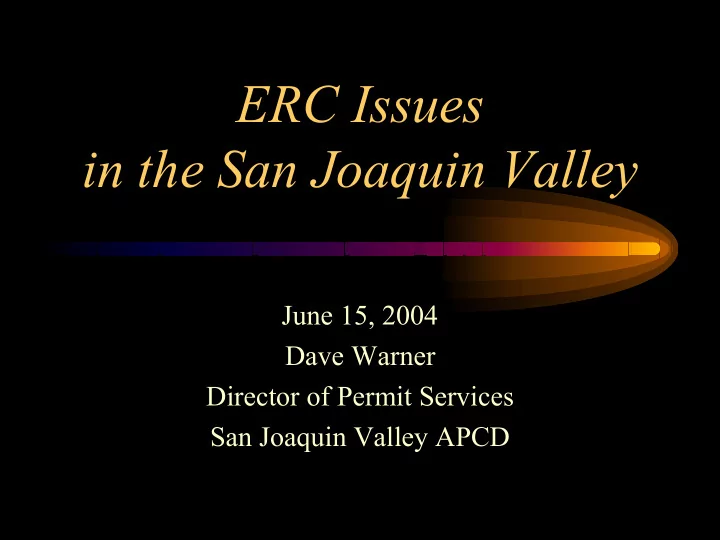

ERC Issues in the San Joaquin Valley June 15, 2004 Dave Warner Director of Permit Services San Joaquin Valley APCD
Today’s Discussions • What are ERCs and how are they used? • ERC Issues (Surplus, pre-1990, new credits) • NSR Equivalency Tracking and the “Hammer” • Other considerations (Extreme, Ag, NSR Reform, SB 288) • What’s going to happen to ERCs in the SJV? • Options
What are ERCs? Emission Reduction Credits • Created by voluntary reductions in emissions • Considered valid after District analysis • ERC Certificate issued • Reductions must be real, surplus, quantifiable, permanent, enforceable
How are ERCs used? New or modified Existing source source Decrease in existing New emissions emissions No increase in emissions in the Valley
ERC Issues Surplus Credits • Credits must be “surplus” of required reductions • Surplus-at-time-of-use – Federal requirement – District only looks at “surplus” when banked – Surplus-at-time-of-use reduces value of ERCs
ERC Issues Surplus Credits • Arguments against surplus-at-time-of-use: – Takes valuable property from those who are ahead of pollution reduction requirements – Stifles early or innovative reductions – Use of un-surplussed credits doesn’t affect attainment efforts when properly accounted for in plans • So far, we’ve only been partially successful with these arguments
ERC Issues Pre-1990 Credits • Reductions banked before the 1990 amendments to the federal Clean Air Act • Accounting issue, largely resolved • Current PM-10 Plan properly accounts for pre-1990 credits • Future ozone plans will, too.
ERC Issues Creation of new credits • Gets tougher all the time • Any easy reductions are already made, or are already required (no longer surplus) • Innovative credits are generally difficult to get EPA approval of
NSR Tracking System • Part of Rule 2201 (New Source Review) • Purpose is to demonstrate equivalency: District’s offset requirements versus Federal offset requirements
NSR Tracking System • Quantify increases in emissions from units that require federal offsets: – New Major Sources – Major Modifications • Calculate the ERCs necessary to offset these sources per federal requirements
NSR Tracking System • Quantify offsets required by District program • Calculate “extra” reductions resulting from the District’s permitting program: – Lower offset thresholds – Higher offset ratios – 10% cut from banked credits – Un-banked reductions • Determine which reductions are surplus
NSR Tracking System • First test: Compares federal offset requirements to offsets required by District program. • Second test: Compares federal offset requirements to all District offsets and extra reductions (after these reductions are “surplussed” for requirements in existence on the date when the reductions were used).
NSR Tracking System A “Hammer” falls if we fail either test • Fail 1 st Test (quantity of offsets): District must retire add’l credits until shortfall is made up. • Fail 2 nd Test (surplus credits): District must require all new major sources and major mods to use surplus-at-time-of-use credits, until shortfall of surplus reductions is made up.
NSR Tracking System • Annual equivalency demonstration report for August 20 to August 19, due to EPA on November 20 of each year. • Successful for the last two years • This year: potential problem – CEC approval of a major power plant – Probable shortfall of surplus NOx credits
Other Considerations • “Extreme” ozone non-attainment – District board voted to go “extreme” – “Extreme” permitting rules due mid-2005 – Major source trigger reduced to 10 tons/year – Same as current offset trigger, so fewer “extra” offsets generated by district program – NSR Equivalency Tracking will likely fail • Status of “Extreme” determination in light of new 8-hour ozone standard regulations?
Other Considerations Permitting of Agricultural Sources – SB 700 created new permitting requirements for agricultural sources – Offsets not required for some (all?) agricultural operations, per state law – Also means ERCs generally can’t be generated by agricultural sources
Other Considerations Federal NSR Reform – Provides for exemptions from “Major Modification” determinations – District must revise rules by mid-2005 – Should not be many federal “Major Modifications” after rules are changed
Other Considerations • Senate Bill 288 (Sher) – Prohibits relaxation of New Source Review rules in California (from 12/30/02 versions) – Response to Federal NSR Reforms (seen as a forced relaxation of California requirements) – Probably means that, after changes to District NSR rules to incorporate federal NSR reform, we’ll end up with: • same offsetting requirements as current NSR, but • there will be fewer (zero?) federal major modifications
Other Considerations • Current system seems to work well for non- major sources and non-major modifications: – New sources of 10 tons per year to 25 tons per year, and Non-major modifications, even at major sources • Can offset emissions with valid, un-adjusted credits (of course, this falls apart if we adopt “extreme” NSR rule) • No surplussing-at-time-of-use required • No pre-1990 issues – So value of credits “permanent” for non-major actions
What’s going to happen? • Likely scenario: – Tracking system fails, November 2004 – No “Extreme” NSR rule modifications – NSR Rule rewritten for Federal NSR Reform: • AB 288 prevents relaxation, so offset requirements (actual-to- potential for major actions) must match 12/30/02 version. • But few or no federal “major modifications” for tracking purposes. – So, “only” new major sources would be subject to surplus-at-time-of-use offsetting requirements of the “hammer”. • So, do we care if the “hammer” falls?
Options to Avoid “Hammer” • Incremental surrender of existing ERCs • District administered ERC Bank – 1 st in, 1 st out; to minimize surplussing issues – ERC ownership issues? • Rule establishing fund to generate credits – District would have to find surplus reductions! • Revamp NSR mitigation concept? – probably requires federal legislative action • Other ideas?
ERC Issues If you have comments, questions, answers: dave.warner@valleyair.org
Recommend
More recommend